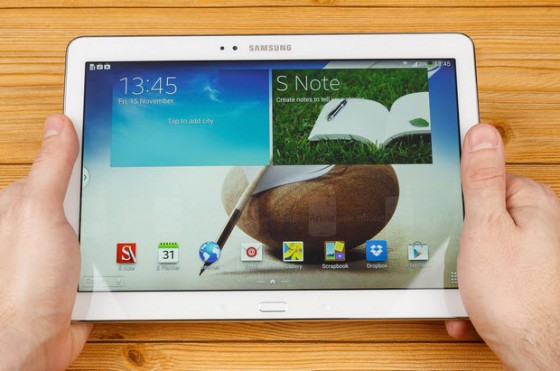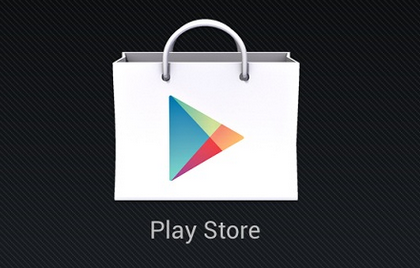
- Photo from phonearena.com
You can’t really expect Samsung to invent simple product names. In 2012 they released a tablet called the Galaxy Note 10.1 tablet. In 2013 they released another tablet called the Galaxy Note 10.1. 2014 Edition tablet. Okay… it’s pretty easy to differentiate between the two tablets’ names. [Insert sarcasm]
With that little note, this article will compare the Samsung Note 10.1 2014 tablet and the iPad Air. This is not a comparison of the 2012 Samsung Note 10.1 tablet.
Price
Usually when you compare Android tablets and Apple’s iPads, you end up with a huge price difference between them, effectively leaving them on two different playing fields. However, the Samsung Galaxy Note 10.1 32GB model costs $599.99 on Amazon and the iPad Air 32GB model costs $659.99. This puts both the Samsung tablet and iPad in the same playing field. With an even price playing field, you can choose which tablet to purchase purely on its specs and personal preference. The iPad Air 32GB is only $60 more expensive, or about 10% more than the Galaxy Note 10.1. That’s not enough for most people to worry about when looking at these tablets.
Dimensions and Weight
The iPad Air weighs one pound, while the Note 10.1 weighs 1.1905 pounds. Whereas the Note 10.1 dimensions are 9.57 x 6.75 x .31 inches, the iPad Air’s dimensions are 9.4 x 6.6 x .29 inches.

Photo from phonearena.com
The diagonal size of the Samsung is 10.1 inches while the iPad is 9.7 inches.
Personal take: The weight difference might not mean too much to most users. However when I look at the Note 10.1 tablet I see right off that bat that it is less wide than the iPad. This isn’t a bad thing necessarily, but depending on your personal preference you might want to take a look into it. I for one think it’s a great shape for watching movies on.
I also like how the bezel width of the Note 10.1 has been reduced when compared to the older 10.1’s bezel width (as seen below):

2012 Galaxy Note 10.1. Photo from phonearena.com
Whereas the 2012 version of the Note 10.1 had an odd form, you can clearly see that the 2014 version has been improved. However, the iPad Air still has thinner size bezels. This makes the content pop out more and not feel so “padded” by the edges:

Photo from phonearena.com

Photo from phonearena.com
Screen
The Note 10.1’s screen is significantly better than the iPad Air. The Note 10.1 has a screen with a 299 pixel density (amount of pixels in an inch), while the iPad has a pixel density of 264. Whereas the iPad Air has a resolution of 2048 x 1536, the Note 10.1 has a resolution of 2560 x 1600.
Depending on your attention to screens, you might not really be able to see the difference. You would have to put the two screens next to each other to truly see how they compare to your personal preference. Also, most people base the quality of screens off of color balance instead of things such as pixel density. Color balance is way easier for the human eye to notice than the amount of pixels per inch. When it comes to brightness, the Samsung Galaxy Note 10.1 has a slight advantage. However, the iPad Air’s color balance far out does the color balance of the Note 10.1
Cameras
The front facing camera of the iPad Air has a resolution of 1.2MP and records at 30fps. The Note 10.1’s front facing camera has a resolution of 2MP and also records at 30fps.

Samsung Note 10.1 Back Camera: Photo from digitaltrends.com
The iPad’s back facing camera has a resolution of 5MP (2592 x 1944 pixels). It records video at 30fps with a resolution of 1080p. The Samsung Note 10.1’s back facing camera is way better on the other hand. It has a resolution of 8MP (3264 x 2448). The Note 10.1’s camera records video at 60fps with a 1080p resolution.
What’s really depressing about the iPad Air is that it does not support slo-mo video like the iPhone 5S does. When you factor in the fact that it also doesn’t have a fingerprint scanner, things start to look a bit odd. Why is such an expensive device missing technology that Apple has already mastered?
Battery

The Note 10.1’s battery lasts about 7.5-8.5 hours throughout normal web browsing, HD video streaming, emails, and other basic use. The iPad Air gets a similar amount of battery time per charge. So there isn’t really any battery difference between these two tablets. Apple would tell you that the iPad Air can last up to 10 hours, but in reality that turns into 7.5-8.5 hours.
Processors
The Note 10.1 has a quad core 2.3GHz 32-bit processor, while the iPad Air has a dual core 1.4GHz 64-bit processor. They both have graphic processors that handle modern games, and future games to come really well.

Samsung Note 10.1 (2014 Edition)
Just looking at pure hardware doesn’t tell you even half the story behind which tablet you need to get though. Consider that the Note 10.1 runs Android which is known for having an inefficient multi-tasking system. The iPad Air on the other hand runs on iOS 7, which has been perfected by Apple ever since it created the smartphone craze.
What this translates into is this: On the Note 10.1 you might have two extra cores running at 50% extra processing power, but you will also be running Android on it. When you play a game, Android might easily continue to process other tasks in the background. On the iPad Air, the operating system would only process the game. So in the end it all evens out, and you get very similar performance when using games and apps.

Do you like the Play Store or App Store better?
So you might say “Okay… The game and app performance is basically the same even though they have different processors. Which one is better?” In that case you would have to ask yourself the age-old question of Android vs iOS. It’s really whichever operating system has the best app market for your needs.
A Note about Processing Power
If you’re a gamer you might want to go with the iPad Air, but if you use certain apps for your business that are only available on the Play Store, then your decision will be easy. However you should never just jump on the Note 10.1 or any other tablet when you see that it has a 4-8 core processor, because it doesn’t really give justice to the experience you will get from the phone.
Don’t believe me? Then do some research into AMD 8-core 4.0GHz processors that cost $300, and Intel 4-core 3.6GHz processors that costs $800. You will surprisingly find that the Intel processor performs better for computing tasks, than the AMD processor does, even though the pure spec sheet says otherwise.
A great example of consumers being misleaded by specs is when they look at a phone camera’s megapixels. When the iPhone 5 came out it had an 8MP camera, whereas the Nokia 808 Pureview had a 41MP camera. You might then assume that the Nokia 808 camera is 5 times better. It’s not:

No-light shots: Photo from pocketnow.com
The conclusion to that thought is to never look at specs as the sole reason for buying a phone. There are many other factors that effect the performance of the phone in real world scenarios.
Storage
You can get the Note 10.1 in 16GB, 32GB and 64GB. The iPad Air comes in all of these sizes, but it comes in 128GB as well. The only difference between these two tablets is that the iPad’s storage is not expandable. If you get a Note 10.1 16GB model and realize you need more space later on, you can easily buy a microSD card and expand your phone’s storage size.
If you have an iPad 16GB model on the other hand and you want to do the same thing, you’re out of luck.
Cool Perks
When you buy a Note 10.1 (2014) model from Amazon, you get $600 of free content such as a Hulu Plus membership, Google Play credit, Businessweek subscription, and so forth. The Note 10.1 also has a stylus which you can use to access the tablet, draw or take notes.
The Note 10.1 also has an NFC chip which lets you transfer photos and videos with other NFC enabled phones. NFC is much more energy efficient and faster than the outdated Bluetooth technology iDevices still use for nearby data transfer.

The iPad Air’s “cool perks” are that it runs on iOS which is renown for its stability, beauty and quality apps. Other people will also know right off the bat what your iPad is when you take it out. I’m not saying this is a good thing because you can “brag” to them. Rather I’m saying this is a good thing because if you have a Note 10.1, and your friends see you using it, you will have to explain what it is: “It’s a Samsung Note 10.1 2014 edition tablet.” Who wants to go through that hassle? Especially when people will just say “The iPad costs just as much. Why not get that?”
The iPad is definitely a “brand product” where most of the money you pay for it, just goes towards the name and being able to say you have an iPad. Heck, even the logo is something you pay for. For some people these things are important. I know that I would rather get an iPad Air over a Samsung Note 10.1 tablet. Mainly because the Note 10.1’s name is so ridiculously long and unnatural.
Conclusion
If you’re big into movies then the Samsung Note 10.1 2014 edition tablet might be what you’re looking for. It has a form factor that is perfect for widescreen movies. However if you’re looking to game, then the iPad will provide you with the app store which is home to many quality apps.
If you’re just into email browsing, movie watching, and getting business tasks done on the go, then the Note 10.1 might be a good match for you. The Note 10.1 comes with a lot of extra perks, a stylus, and NFC.

Photo from phonearena.com
When it really comes down to it though, it’s all about your iOS vs Android preference. Both of these tablets run just as good, and for just as long. They even look really similar. The differences start to show up when you examine Android and iOS, Siri and the app store, and other perks that come with each operating system. The pushing factor for getting either of these tablets over its competitor is not going to be the $60 price difference, or slight spec differences, it’s going to be the operating system. That’s a question you have to answer for yourself.